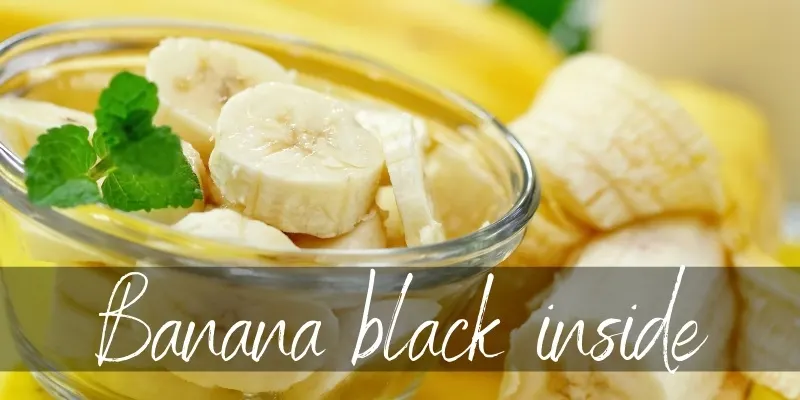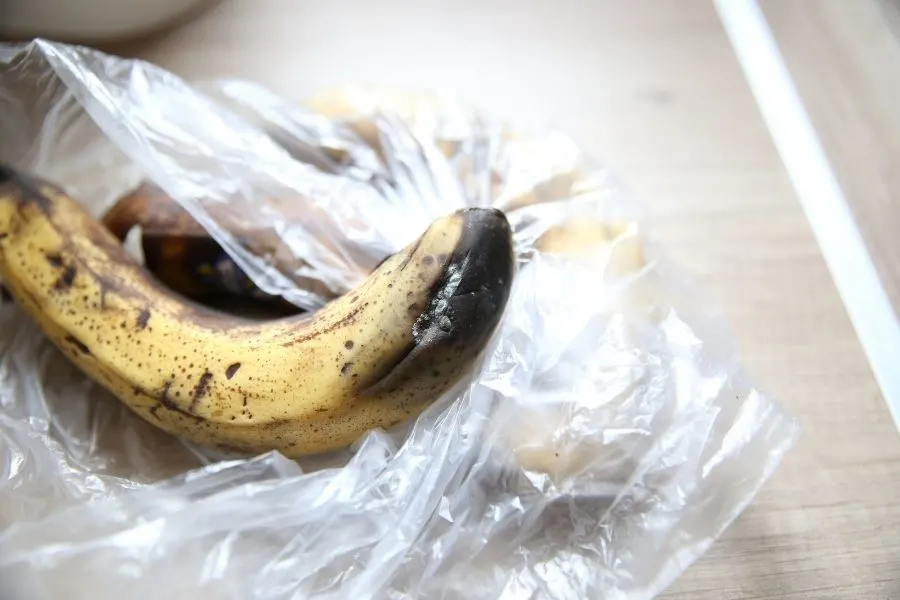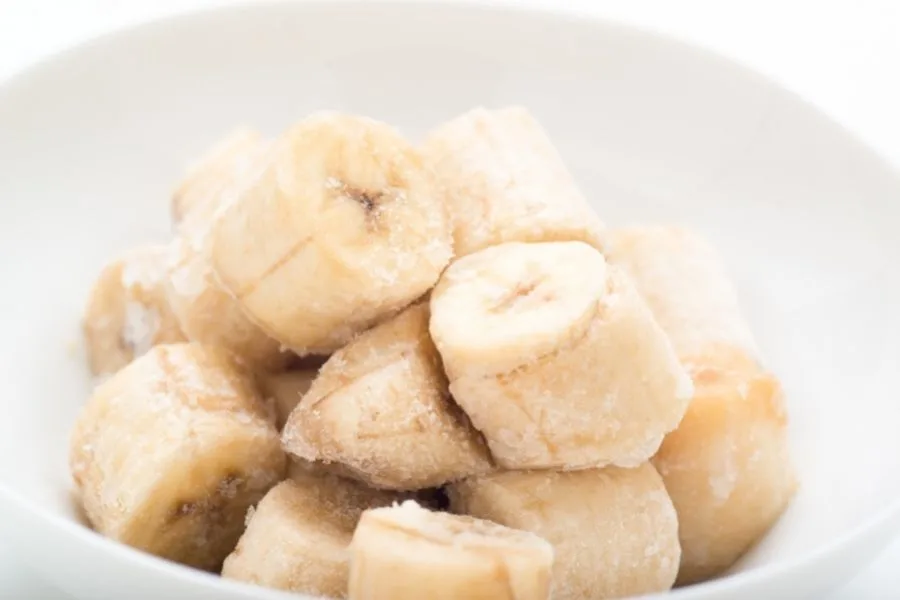Bananas are one of the most popular fruits around the entire world. Their sweet, distinctive flavor matched with their filling, nutrient-rich content makes them an excellent choice for a healthy breakfast, lunch, or snack during the day.
But, have you ever let your bright yellow banana turn black and mushy? Have you ever wondered if it can be eaten once it reaches this stage of ripeness? Well, if so, you may want to read on.

Are bananas black on the inside safe to eat ?
It’s best to check to see why the banana is black, before eating it. If the black part is just a bruise, then yes it’s perfectly safe to eat. If there is a lot of black right in the middle, and the rest of the banana is alright, then throw it out.
That is Nirgispora, a banana disease that hasn’t been documented to harm humans, but we wouldn’t risk it.
Now, this seems like common sense, but with bananas, you’d be surprised! Those golden, crescent shaped berries – yes, bananas are actually berries – are shockingly easy to bruise. Simply press your finger onto their tough outer hide and you’ll soon see a brown mark both on the skin and the fruit inside.
Check to see if the banana is rotten
A truly rotten will certainly smell it. The soft fruit inside, as well as its thick covering, will begin to ferment with time, heat, and its own ethylene gas. Ethylene is a plant hormone that gives bananas their distinctive smell. It’s also what helps them make other fruits ripe when placed in close proximity to them.

Therefore, this ethylene fermentation will cause your once bright yellow banana to quickly ripen itself, then over-ripen itself, and finally, rot and mold will overtake the fruit. Once this happens, your banana will take on the characteristic rotten, moldy stench, which will permeate the old banana’s surroundings.
Rotten bananas will also begin to feel mushy and viscous beneath their now greasy black peel, almost like a very small, very smelly waterbed hammock, if that were a real thing.
So, with that image in mind, make sure you chuck bananas that match the above description. If you don’t, the once beautiful, fragrant fruit will attract fruit flies and wreak havoc on your body when eaten.
Read also: Why Do Bananas Turn Brown In The Fridge ?
If the bananas are brown they’re fine
Oftentimes, brown bananas are mistaken for rotten ones. Many people are struck with fear at the sight of just a few brown spots on their bananas. And this fear is not just over bananas; thousands of pounds of food are wasted every year simply because they do not look “perfect” enough for the average consumer.
But now you know that browning bananas do not have to be thrown out. No food waste there!
Even if your banana’s peel is more black than brown, just peel it open and make sure the fruit is still a light yellow color. If it’s got some brown spots inside, that’s fine, too. Just cut out any deep black patches, particularly around the seeds where rot will form first.
In fact, when bananas begin to turn brown, they actually become even more flavorful and nutritious. As a banana goes from green to yellow to slightly brown, its levels of antioxidants actually rise!
Not to mention, bananas are just so much sweeter and more delicious as they brown! This is due to the starch inside them breaking itself down into a simpler form – sugar!
The texture of brown bananas is also much softer than unripe or pure yellow ones. This makes it much more pleasant to eat, especially if you’re just beginning to wean your baby onto real foods.
How to store bananas
So, now that you know just how delicious browned bananas can be, you may be wondering how exactly you can keep them that way. After all, in just a few hours, they may become overripe and spoiled.
So, we’ve put together a few ways you can preserve that wonderful, sweet banana flavor way past its own shelf-life.
Freeze Them
If you want to maintain the quality of your brown bananas, freezing them ripe is a quick and easy way. You can actually freeze your unspoiled bananas for up to six months. That’ll certainly give you enough of time to decide what to do with them.
There are many ways you can freeze your bananas, each dependent on your freezer space and desired uses. Bananas can be frozen whole, sliced, or mashed. But, as two rules of thumb, you should always peel them first and make sure they are in fact browning already.

If you freeze your bananas before they are ripe, they’ll just skip the brown ripening phase and go straight to black and rotten after thawing.
Make banana ice cream
If you’re lactose intolerant or simply want to try out a new, unique sweet treat with your browned banana, listen up.
Once your bananas have turned brown, you’re going to want to slice them up. Then, throw them into the freezer for a few hours, overnight, or even a few days. Then, throw the frozen pieces into the blender, add some unsweetened cocoa powder to the mix, and blend till smooth and creamy!
In no time, you’ll have delicious, dairy-free banana chocolate ice cream, no sugar added. You can do this with less ripe bananas, and the final texture will be denser.
Fry the bananas
If you’ve noticed those brown dots beginning to form on your bananas and want to quickly use them right away, frying them might be your answer. Fried bananas can last up to three days in the fridge, so don’t worry if you can’t finish this sweet treat all in one sitting.
To fry your bananas, first, you must make sure they are quite ripe; that means their peels have got to be either mostly brown or entirely brown (but not black!).
Once they reach this level of ripeness, simply unpeel, slice, and throw into a frying pan coated with a little butter! Add some sugar, cinnamon, or honey and sizzle until beautifully golden and shiny. These go great with some vanilla ice cream on the side.
Bake the bananas
Yu can use bananas in a bread, cake, or muffin! If the above cooking methods don’t appeal to you, or you’re simply in the mood for a nice, warm loaf of banana bread, your browned bananas are perfect for that, as well.
All you have to do is pick your recipe and use up those ultra ripe bananas before they begin to spoil. Soft, brown bananas will actually make the sweetest, most delicious baked goods compared to their green or yellow counterparts.
Just watch out for your recipe’s sugar suggestion. Chances are, if your bananas are as ripe as they should be, you won’t need to add all that much sugar to the mix.
You can also bake your ripened bananas on their own, making them into dehydrated, crunchy-sweet chips. For this, just peel, slice, and place in the oven until crispy!
Read Also:Are Wild Bananas Edible ?
How to make bananas brown
If all this talk of tasty, brown bananas has got your mouth watering, you may also be wondering how you can get your green bananas ripe fast. Oftentimes, bananas you can buy at the grocery store are unripe, and it may seem daunting to wait days for them to turn brown on their own.
However, if you’d like to get them brown in no time, simply place your unripe bananas into a brown paper bag, seal it up tight, and wait for either 12 hours or a full 24 depending on your preferences. Remember the ethylene gas we spoke of earlier? This is exactly what will permeate the bag, making your bananas sweet and brown in no time.
Conclusion
In conclusion, we can say that most of the bananas that are black inside are safe to eat, especially if they are brown-ish and not entirely black. It is up to you if you like to eat bananas that have brown spots inside. I know people who prefer them that way and they are here with us to tell the story, so it is pretty safe.
I hope this article helped you to know what to do when you see bananas that are black or brown inside.

